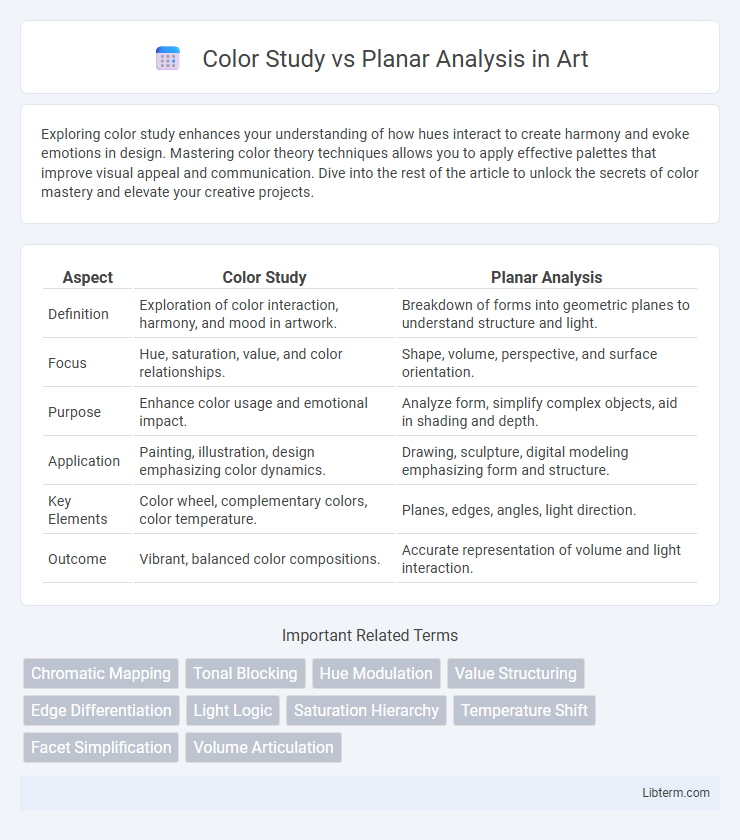Exploring color study enhances your understanding of how hues interact to create harmony and evoke emotions in design. Mastering color theory techniques allows you to apply effective palettes that improve visual appeal and communication. Dive into the rest of the article to unlock the secrets of color mastery and elevate your creative projects.
Table of Comparison
| Aspect | Color Study | Planar Analysis |
|---|---|---|
| Definition | Exploration of color interaction, harmony, and mood in artwork. | Breakdown of forms into geometric planes to understand structure and light. |
| Focus | Hue, saturation, value, and color relationships. | Shape, volume, perspective, and surface orientation. |
| Purpose | Enhance color usage and emotional impact. | Analyze form, simplify complex objects, aid in shading and depth. |
| Application | Painting, illustration, design emphasizing color dynamics. | Drawing, sculpture, digital modeling emphasizing form and structure. |
| Key Elements | Color wheel, complementary colors, color temperature. | Planes, edges, angles, light direction. |
| Outcome | Vibrant, balanced color compositions. | Accurate representation of volume and light interaction. |
Introduction to Color Study and Planar Analysis
Color Study involves analyzing the use of hues, saturation, and value to understand the emotional impact and visual hierarchy in an artwork, optimizing color harmony and contrast. Planar Analysis examines the geometric construction of forms through simplified planes, enhancing the understanding of volume, light, and shadow for accurate representation. Both methods are crucial for artists to develop spatial awareness and dynamic compositions, with Color Study emphasizing chromatic relationships and Planar Analysis focusing on structural form.
Defining Color Study in Art
Color Study in art involves examining the interaction of colors, tones, and hues to understand their visual impact and emotional effect within a composition. It emphasizes exploring color relationships, contrasts, and harmonies to enhance the viewer's perception and mood. Unlike Planar Analysis, which focuses on the structural breakdown of forms and shapes, Color Study prioritizes the expressive and atmospheric qualities conveyed through color.
Understanding Planar Analysis
Planar Analysis examines the spatial organization of surfaces within an image, breaking down complex forms into simplified planes to better understand light, shadow, and depth effects. Unlike Color Study, which emphasizes color relationships and palettes, Planar Analysis prioritizes structural comprehension by focusing on geometric shapes and gradients. Mastering Planar Analysis enhances an artist's ability to depict volume and perspective accurately, improving overall image realism and composition.
Key Differences Between Color Study and Planar Analysis
Color study emphasizes the analysis of hue, saturation, and brightness to understand visual impact and emotional response, while planar analysis focuses on breaking down forms into geometric planes to analyze structure and spatial relationships. Color study is fundamental in fields like painting and digital design for mood and atmosphere creation, whereas planar analysis is essential in architecture, sculpture, and technical drawing to understand form and light interaction. Both methods complement each other but differ primarily in their focus on color properties versus geometric form decomposition.
The Role of Light and Shadow in Each Method
Color Study emphasizes the interplay of light and shadow through variations in hue, saturation, and brightness to capture atmospheric effects and mood. Planar Analysis simplifies forms into flat planes, using light and shadow to define structure and spatial relationships without color complexity. The Role of Light and Shadow in Color Study enriches emotional expression, while in Planar Analysis, it clarifies geometric form and depth.
Techniques for Effective Color Study
Effective color study techniques emphasize systematic observation of hue, saturation, and value relationships, ensuring accurate color harmony and balance. Utilizing color swatches and digital tools like Photoshop's color picker enhances precision and consistency in selecting complementary or analogous palettes. Incorporating lighting studies provides insight into color behavior under different environmental conditions, differentiating color study from planar analysis, which prioritizes geometric structure and spatial relationships over chromatic nuances.
Approaches to Mastering Planar Analysis
Mastering planar analysis involves understanding the geometric relationships of light, shadow, and form on surfaces, which enhances the ability to depict three-dimensionality accurately. Practical approaches include breaking down complex subjects into simplified planes, using tools like edge detection and value mapping to analyze angles and light directions. Consistent practice through observational drawing and study of classical sculpture deepens spatial awareness and strengthens the ability to translate planar structures into dynamic compositions.
Combining Color Study and Planar Analysis
Combining color study and planar analysis enhances the visual comprehension of spatial compositions by integrating hue differentiation with geometric structure evaluation. This approach allows artists and designers to optimize contrast and depth perception while maintaining balanced form and perspective accuracy. Utilizing both methods simultaneously supports a cohesive interpretation of light, shadow, and surface orientation for more dynamic and engaging visual narratives.
Common Mistakes and How to Avoid Them
Color study often suffers from overgeneralization, where subtle hues and gradients are overlooked, leading to flat or unrealistic visuals; precise observation and swatching can prevent these errors. Planar analysis is frequently misapplied by neglecting the true three-dimensional form, resulting in inaccurate light and shadow distribution; mastering perspective and anatomy is crucial to avoid such mistakes. Combining detailed color observation with accurate planar form understanding enhances the realism and depth in artwork.
Conclusion: Choosing the Right Approach for Your Artwork
Selecting the right method between Color Study and Planar Analysis depends on your artwork's goals and style. Color Study emphasizes emotional impact and mood through strategic color choices, ideal for expressive and dynamic pieces. Planar Analysis focuses on structure, form, and lighting to achieve accurate three-dimensional representation, making it essential for realistic and detailed renderings.
Color Study Infographic

 libterm.com
libterm.com